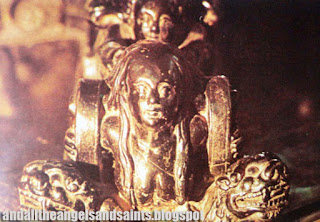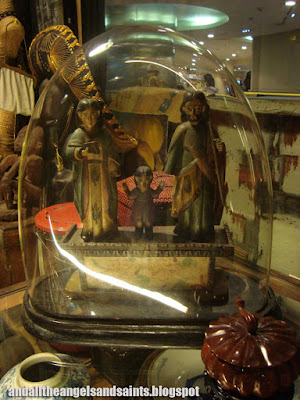In the course of my over three decades of antique santo collecting, I wish I could say I have seen everything, been there, done that. But as they say, collecting takes a lifetime, and you never really stop looking around. That's collector's instinct!
But I certainly have seen a lot, and this article is all about that—the things my eyes have seen through all these years—beautiful santos, ugly santos, folk santos, elaborate tableaus. Then there are the antique shop pieces that I could not afford, pictures of ivories e-mailed to me for my consideration, heirlooms for sale by families, tabletop images peddled by middlemen. And what about those santos that got away? I have since retired from santo collecting, but whenever I see these pictures, I still get a tinge of regret, leading me to ask myself—now, why didn’t I get that? I don’t even know what happened to these santos—most of them, I presumed must have been sold, re-sold or in still on somebody’s shelves, as these were taken many years ago.
SANTO NINO DE TONDO PRINT. This is just a vintage print, but I thought this Sto. Nino of Tondo. Manila vintage illustration on paper is a nice piece. Maybe this was a souvenir print sold during the fiesta of Sto.Nino. The original frame is so 1950s. But then, my walls are already crowded with paintings and framed artworks.
UNIDENTIFIED MALE SAINT. A friend sent this photo of a chapel-sized santo of a male saint for identification. I thought it looked like either St. John Berchman or St. Gerard Majella. But the habit is all wrong for either of the two. For once, I was stumped.
SAGRADA FAMILIA, ANTIQUE BONE. I got all excited when a dealer showed me this picture of the Holy Family, which looked like they have ivory parts. but I am convinced they're of bone. Just look at where they are...are they being kept in the pantry? Well, the owner of thes eimages supposedly changed his mine, so goodbye Jesus, Maria y Jose!
CALVARIO. I was snooping around Cubao, when I chanced upon this very large figure of a crucfied Christ. Looks very 50s to me, and well made. I made an even startling discovery when I found two companion pieces--a San Juan and a Dolorosa--lying close by. So, this was a Calvario tableau after all! But too expensive--I think the dealer read my reaction. besides, the tableau is humongous, I can't put it on my dining table!
SAN ISIDRO LABRADOR. I was invited by dealer to see some pieces in her Angeles warehouse, but I ended up eyeing this 40 inch San Isidro de Labrador--with a chopped nose. There it stood on her dresser, along with new Santo Ninos for contrast. The 3 foot image is exquisitely carved and has a nice patina--surely, this is century old! I wanted it--despite the fact that it had no cows, angel and the kneeling landlord. I made an offer that was soundly rejected, and I came home empty-handed.
SAN ANTONIO, ANTIQUE IVORY. A dealer apparently got my e-mail address from a friend, and introduced herself to me. ong with her mail came a pai of santo pictures---they are for sale, she said. The first piece is an all-ivory San Antonio with beautiful estofado painting on his vestments still intact, thanks to its virina. The santo wears a silevr halo, and stands 8 inches tall.
CRISTO CRUCIFICADO. The second ivory image looks to be much older--as the all-ivory corpus of the crucified Christ has mellowed to an earthly orange-brown color. All the silver accessories are intact, which makes the oiece more appealing to me. The dealer promised to get bck to me for the prices, but she never did. Well, just form the looks of these pieces, I don't think I can afford them anyway!
ANTIQUE CALVARIO, IVORY AND WOOD. How can I forget this piece?? A Guiguinto dealer sent this picture by phone which I got while I was in transit--riding a car. It is surprising that the figure of the crucified Christ is the only one in wood, not ivory. But the manikin figures that surround Him--Mary. Magdalene and John--are incredible pieces. The problem was--I dilly-dallied and deferred my visit to the shop--and so it went to to a collector with more conviction, and with more money, for sure.
SAN PEDRO FOLK SANTO. My opinion is always solicited by few friends before they buy a santo, so that's how I got my reputation as the go-to person when it comes to santo evaluation and pricing. I am flattered, but I don't consider myself an expert, I guess I am more exposed becuase I go out a lot, even with 20 pesos in my pocket. This charming folksy, younger-looking San Pedro, around 2 foot tall, was being considered by my friend. It even has his "bulik" rooster by his side. The colors are strong and vibrant. And that santo face!!! Doesn't the saint look like Bruno Punzalan? So, what better advice to give my friend than to tell him--"get it, get it!"
SAN JUAN BAUTISTA. I ws alerted by a Bulacan dealer about this museum quality San Juan Bautista that looks so ancient, by all standards, Just look at the facial carving, the details of the hair and the belted camel-hair garment. As expected, the colonial santo carried hefty 6-digit price tag. I just looked and sadly turned away. I heard that the piece went dealer-hopping before it found a buyer in Manila.
SANTO NINO, POLYCHROMED SANTO. I got all excited when my suki from Bangkal, Makati sent two Bohol santo images that she said were on their way to her thrifts shop. I coul not believe my eyes--one was a Sto. Nino with a tin crown, brilliantly painted and stnding on a four-cornered rococo base. The other hitch was that---they have no prices yet. Hmmm..Red flag alert! And then I saw the next piece...
INMACULADA CONCEPCION, POLYCHROMED SANTO. A small Bohol Virgen with a trademark cherub at her foot!! She wears a tin crown, and robe full of wavy folds and drapes. Her coloring was superb!!! But then, when they finally arrived, the santos had sustained some damage. The crown of the Sto. Nino and the facial aureole of the Inmaculada were crushed and ruined. Worse, the owner threw them away!! The price for the two could have been reasonable, but I asked for a discount considering the loss of the metal accessories. But the owner was firm, and I lost interest. Next!
SAN ANTONIO VINTAGE SANTO. While still in Bangkal, Evangelista, Makati, I saw this vintage San Antonio painted in house paint. Not exactly my cup of tea, but I was struck by the square-jawed saint who sort of reminded me of Dick Tracy.
LA PIEDAD. This Holy Week processional santo showing the Mary cradling her Son, the dead Christ, though carved in the classical tradition, lack the flowing lines of other La Piedad images I have seen. The poses are a bit rigidd, almost stiff. But that does not retract from the value of this old image. The owner was vacillating whether to sell it or not--so I thought it was better to give him more time to think about it. I never saw the images again.
STA. VERONICA. This small processional image of La Veronica was offered to me sometime in the mid 1990s by a San Fernando dealer. Though old, I really din't like it because it was so expressionless (missing glass eyes), and was carved without flair. See how ramrod straight she stands? Sometime in early 2000s, it resurfaced in the house of another dealer in Sta. Rita. Is she following me after her rejection? Well, I rejected the image again.
MATER DOLOROSA, ANTIQUE IVORY. There was this dealer I met who kept cajoling me to check out his stock. I actually did and found nothing of interest. When he sked me what I was looking for, I said I was looking for an ivory Dolorosa. He got my number and promised to get back to me. Months later, I had a call from him--he wanted to check a Dolorosa that was with him. nd it was for sale. I rushed to his shop and found this lovely piece! I wanted it! Problem was, he said he has to confer with the seller for the price. Disappointed, I left his place.When I called him again, he said that the price has been sold, better luck, next time. Nope...there will be no next time.
SAN ROQUE. This is a tall image of San Roque--and it is complete. As you can see, the best carved figure is the saint himself; the angel and the dog are mediocre works, maybe done by a separate carver.Though complete and not too expensive, I was not sold on this image. That's maybe how other collectors may have felt, too, as the piece went from one shop to another and went unsold for many month
SAGRADA FAMILIA FOLK SANTOS IN A VIRINA. When i was still working in Makati, I would take the train from Ayala station so I could have lunch at Shangrila Mall. There was also an an antique shop there, and this folk grouping of the Holy Family caught my eye--only because the oval virina and its original base was more appealing to me than the images. Alas, the seller said I have to buy the whole assemblage, which does not make sense as the wooden folk santos are better off displayed in a folk urna. I had heavy dessert instead.
\
STA. RITA DE CASCIA. When I chanced upon this spectacular church-size santa carved in the round, I stood stupefied. It was beautiful!!! It had this imploring look on her face that semm ot say--"buy me! buy me!". I wasn' sure as to her identity, but my instinct tells me she is Sta. Rita, despite the absence of her trdemark stigmata (or perhaps, I didn't check her forehead due to extreme excitement. I wasn't too sure of her age either. But most of all, I wasn't sure if this was stolen and carted off by unscrupulous thieves for sale to Bulacan dealers. So I held off--I remember it was priced at 70 thousand. I just took a picture and never came back.
INMACULADA CONCEPCION ANTIQUE IVORY. Well, I came back for this ivory Maria many times--at the shop of the late Ramon Villegas at La O center. For some reason, I was fascinated by this piece, which stood almost 16 inches tall (see how her head is touching the tip of the
virina). I guess it's the simplicity of the carving, thiugh not as finely carved, the face exudes an expression of serenity, with a calming gaze. Mon even told me about the image's provenance; he said it came from cfrom an old Quiapo family. I think I visited the shop 4 times, but never got around to making a decision to take her home. When I last visited his shop, his ivory angels were all snapped up, but this Inmaculada remained. When Mon died, I regretted not getting this, even more. Sigh,
















































